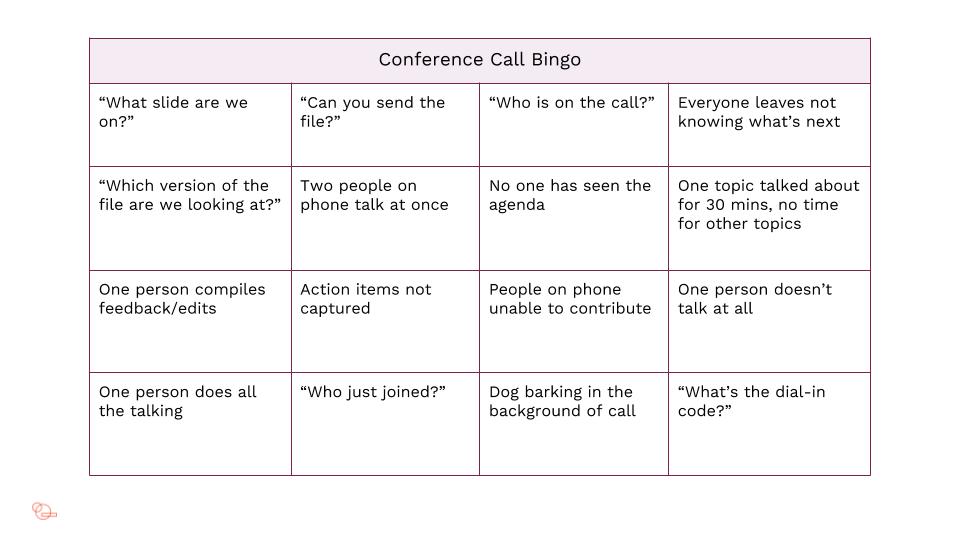Published April 12, 2019 | Updated February 18, 2021 | 6 minute read
For every inefficient, unproductive meeting on your calendar, there’s a blog post on Medium offering some tactical ways to fix it (“schedule it to end 5 minutes early!”, “prepare an agenda in advance!”). Despite this well meaning advice, the problem isn’t changing. In fact, it might be getting worse: there are somewhere between 36 and 56 million meetings every day in the US – it’s time to stop applying band-aids, and talk about how we fix this scourge forever.
First, a story….
A couple of years ago, I was working at an ad agency as a “Senior Project Manager” — although I quickly realized that meant I was actually “Chief Meeting Booker.” There was a shortage of meeting rooms in the agency’s Madison Avenue office so my job predominantly consisted of bargaining with other Project Managers for meeting room space. Because of the lack of rooms, the PMs had booked up rooms for days at a time, often weeks in advance, just on the off chance that they’d be needed.
The issue got bad enough that the CEO sent an all-hands email acknowledging the lack of meeting space and requesting patience while they "looked into the situation". It is only with hindsight and experience of working as a business agility consultant that I see now that the lack of space wasn’t the issue, but the meeting culture itself. In one particularly memorable exchange with an Account Manager, I was asked to book a meeting to debrief the previous meeting and also plan for the next meeting. My suggestion that perhaps we should do some work in between those meetings was not received well. This, despite the fact that our Creative Director on the account proudly wore socks that said “This Meeting Is Bullshit.”
With a few more years of experience in organizational culture change, I realized that the unhealthy meeting culture is actually a symptom of a fundamental structural issue: organizations are still designed to replicate machines and so they operate under the assumption that large groups of people mobilized around a common goal are complicated, like an engine, rather than complex, like an ecosystem. A series of boxes and lines on a chart is no longer enough to explain the true relationships between those component parts, just as a meeting, in its traditional format, can be insufficient to manage those relationships.
That said, the meeting is still the de facto mode of interaction (particularly in organizations yet to fully embrace digital transformation.) As a result, meetings are also the place where we, as organization developers, can sense tension and make test our first hypotheses in improving the organization’s collective health.
Below I break down several reasons why your calendar might be blocked end to end, some classic ways in which to address each of those issues starting tomorrow, and some deeper root causes around meeting culture that aren’t covered in the classic meeting literature.
1. Your meetings lack clear purpose
You’ll know that this is you if any given meeting you’re in can switch rapidly between idle chatter, decision-making, collaboration, group learning, prioritization etc. etc. It may also apply if the conversation can go down long tangents, seemingly unrelated to the main thread of conversation.
You can improve this tomorrow by using the following quick checklist of thing you can start doing tomorrow in each of your meetings:
- A facilitator, or at the very least a time keeper. Someone with the confidence and authority to call when conversation is going off topic.
- An agenda. Good agendas are questions only, and relate specifically to the stated meeting purpose. At August, we encourage agendas to be built in the room at the start of the meeting. That way, everyone can contribute, you can prioritize items to discuss and you don’t spend time before the meeting emailing around agenda edits that no one reads.
You can fix this long-term for your entire organization by doing a Meeting Audit. Ask yourself, what is the purpose of each of your regular meetings. At August, it is our strong conviction that there are only four real meeting purposes:
- Prioritization e.g. Project Planning, rather than Project Doing
- Learning e.g. Retrospective, Feedback gathering
- Collaboration
- Decision making
Many other types of meetings (status updates being the primary culprit, but also information sharing) are much better solved through open transparent systems of information, like a Kanban board. If an individual meeting covers two or more of these purposes, see if you can separate those out within the meeting time, so that you have e.g. 15 minutes of prioritization, followed by 45 minutes of collaboration that actually creates something.
2. You aren’t leveraging technology effectively
You’ll know that this is you if you have a depressingly familiar time playing Conference Call Bingo:

You can improve this tomorrow by effectively using video conferencing software. Seeing everyone’s faces allows for crucial non-verbal communication (hand-raising, nodding, smiling) and builds the trust and empathy necessary for great teamwork. Once you’re set up, nominate one person to share their screen. A shared screen keeps everyone focused on the meeting like nothing else. It’s also ideal for making sure that tasks and assignees are captured correctly.
You can fix this long-term by joining the frontier firms of the age of information who are leveraging the best of communication and collaboration technology. These organizations have learnt that in order to thrive in a changing world, they can’t be slowed down by antiquated methods of communicating and organizing (meetings and emails.)
Seeding and scaling new technologies isn’t for the faint of heart and your strategy will depend on your organizations need, size and agility. Our experience is that the ROI on digital transformation headaches is huge, not just for meetings but for culture, information flow and for the bottom line.
3. Decisions are not being made in meetings
You’ll know that this is you if you’ve ever walked out of a meeting and thought “what did that actually accomplish?”
Meetings are an excellent use of time for having integrated perspectives and productive discourse around difficult decisions. They’re also a great way to look like you’re making decisions while getting stuck in analysis paralysis and death-by-PowerPoint.
You can improve this tomorrow by lowering the bar you have to hit to make a decision. For instance, encourage an experimental mindset by changing your decision making criteria from needing all yes’s, to only needing no no’s. The difference is subtle, but profound. It’s the shift from asking “Is this the perfect answer?” to “Is this safe to try for our business? Will we, at the very least, learn something that allows us to make a better decision later?”
(Sidenote: be sure to make the decision that was made explicit, and written down somewhere. The easiest may to sabotage the progress of an organization is to continually re-open the advisability of decisions that have already been made.)
You can fix this long-term in a couple of ways: the first would be to define clear decision rights for everyone. (I like to use the tree model for decision rights from Fierce Conversations.) In this way, you’re actually stopping unnecessary decisions from coming to a meeting in the first place, and ensuring that information regarding the decision is shared in advance. If a decision does come to a committee, then your decision rights model will make it clear who should bring an initial proposal for that decision. You’re encouraging the proposal holder to integrate perspectives before you even get in the room, and to separate the deliberation from the decision making.
5. You’re inviting too many people
You’ll know that this is you if the average no. of people at any given meeting is above 9. Studies show that beyond this, the number of connections between individuals becomes too great and humans struggle to cope with this much complexity.
You can improve this in the short term by taking a leaf out of Steve Jobs’ book and questioning the presence of specific people at meetings, or questioning your own presence, even if the meeting organizer is Barack Obama. If you walk into a meeting room with more than 9 people in it, ask everyone to justify their presence, or whether there is something else they could be doing and simply receive the meeting notes. If you’re a leader invited to a meeting with more than 9 people, delegate attendance to one of your team members and ask for a short report back. You’ll increase their engagement through autonomy and responsibility; you’ll also save yourself some time.
You can fix this long-term people by making sure that people have a clear idea their roles, responsibilities and assignments are. Make these explicit, transparent, and don’t rely on old job descriptions: look at the current state of play and be ruthless in cutting out unnecessary items.
Not all meetings or meeting cultures are bad - I’ve worked in places where this was a non issue. However, if you’re stuck in a dull, ineffective meeting, pull out your notebook, pretend you’re taking notes on the meeting and really interrogate the organizational circumstances that led you to be there. Repeatedly ask yourself “Why?” to dig deeper into the issue. You never know where you might end up.


.jpg)






